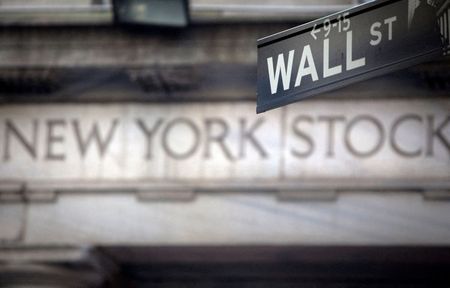
By Noel Randewich and Amruta Khandekar
(Reuters) – Wall Street finished sharply higher on Tuesday, lifted by Apple, Tesla and other megacap growth stocks after strong retail sales in April eased worries about slowing economic growth.
Ten of the 11 major S&P sector indexes advanced, with financials, materials, consumer discretionary and technology all gaining more than 2%.
Investors were cheered by data showing U.S. retail sales increased 0.9% in April as consumers bought motor vehicles amid an improvement in supply and frequented restaurants.
Recently punished shares of Microsoft Corp, Apple Inc, Tesla Inc and Amazon gained between 2% and 5.1%, driving the S&P 500 and the Nasdaq higher.
Tuesday’s broad rally followed weeks of selling on the U.S. stock market that last week saw the S&P 500 sink to its lowest level since March 2021.
“The largest pockets of stocks that investors tend to buy have been essentially beaten up. They’re either in correction or bear market territory,” said Sylvia Jablonski, chief investment officer of Defiance ETF. “I think investors are looking at these opportunities to buy on the dip, and I suspect that today is a good day to do that.”
The S&P 500 Banks index jumped 3.8%, with Citigroup climbing almost 8% after Warren Buffett’s Berkshire Hathaway disclosed a nearly $3 billion investment in the U.S. lender.
Another set of economic data showed industrial production accelerated 1.1% last month, higher than estimates of 0.5%, and faster than a 0.9% advance in March.
“This is consistent with continued economic growth in the second quarter and not a recession underway,” said Bill Adams, chief economist for Comerica Bank in Dallas.
The U.S. Federal Reserve will “keep pushing” to tighten U.S. monetary policy until it is clear inflation is declining, Fed Chair Jerome Powell said at an event on Tuesday.
Traders are pricing in an 85% chance of a 50-basis point rate hike in June.
The S&P 500 climbed 2.02% to end the session at 4,088.85 points.
The Nasdaq gained 2.76% to 11,984.52 points, while Dow Jones Industrial Average rose 1.34% to 32,654.59 points.
Underscoring Wall Street’s recent volatility, the S&P 500 has gained or lost 2% or more in a session some 39 times so far in 2022, compared to 24 times in all of 2021.
GRAPHIC-S&P 500’s busiest trades – https://fingfx.thomsonreuters.com/gfx/mkt/zgpomemlwpd/SPX_by_busiest_trades.png
Walmart Inc tumbled 11.4% after the retail giant cut its annual profit forecast, signaling a hit to its margins. That marked the biggest one-day percentage drop for Walmart’s stock since 1987.
Retailers Costco, Target and Dollar Tree fell between 0.8% and 3.2%.
United Airlines Holdings Inc gained 7.9% after the carrier lifted its current-quarter revenue forecast, boosting shares of Delta Air, American Airlines and Spirit Airlines.
A positive first-quarter earnings season has been overshadowed by worries about the conflict in Ukraine, soaring inflation, COVID-19 lockdowns in China and aggressive policy tightening by central banks.
The S&P 500 is down about 14% so far in 2022, and the Nasdaq is off around 23%, hit by tumbling growth stocks.
U.S.-listed Chinese stocks jumped on hopes that China will ease its crackdown on the technology sector.
Advancing issues outnumbered declining ones on the NYSE by a 2.92-to-1 ratio; on Nasdaq, a 3.19-to-1 ratio favored advancers.
The S&P 500 posted one new 52-week high and 30 new lows; the Nasdaq Composite recorded 24 new highs and 126 new lows.
Volume on U.S. exchanges was 12.0 billion shares, compared with a 13.3 billion average over the last 20 trading days.
(Reporting by Amruta Khandekar and Devik Jain in Bengaluru, and Noel Randewich in Oakland, Calif.; Editing by Shounak Dasgupta and Lisa Shumaker)

